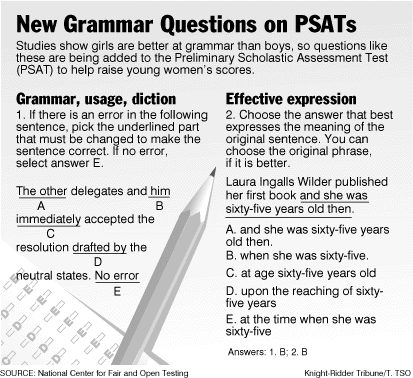
"These changes will end up substantially narrowing the gender gap and will give girls millions of dollars more in scholarships that they have earned," said Bob Schaeffer, public education director for FairTest. Similar changes are not anticipated for the SAT or ACT exams because it's hard to adjust those tests to accommodate myriad ethnic and racial groups. When standardized tests such as the SAT first became widely used after the influx of veterans returning from World War II, mainly affluent white men took them. Since then, many more women and minorities have sought higher education. Test questions involving polo matches or investments have since been adjusted to eliminate material that would lead to overt cultural or gender biases. But critics still say the tes ts' design favors white males and puts women, minorities and low-income students at a disadvantage.
The timed multiple-choice tests are best suited for boys' personalities, educators say, because they tend to approach the test like a game and are more confident taking guesses. Girls are generally reluctant to guess and spend more time trying to figure out the right answers, these educators say. Meanwhile, those with first languages other than English can get tripped up on both the verbal questions and the math section's word problems. The tests also reinforce the education deficiencies many minorities already face. And those from low-income fam ilies often can't afford the expensive test-preparation courses that their wealthier peers attend.
Critics of standardized tests point to scores that consistently show a performance gap among genders and races. For example, males scored an average of 40 points higher than females on the 1997 SAT. Among racial and ethnic groups, Asians had the highest average scores, 1,056 out of a possible 1,600 points for the verbal and math sections combined. Whites followed closely, at 1,052. Then came American Indians, 950; Hispanics, 934; Mexican Americans, 909; Puerto Ricans, 901; and blacks, 857. Nearly 300 colleges and universities -- about 10 percent of institutions nationwide -- have begun ignoring standardized test scores altogether as they try to increase diversity and counteract rollbacks in affirmative action. Instead, they are selecting students on the basis of grades, essays, family income, community activities and personal interviews.
In Texas, for example, after last year's U.S. circuit court ruling banning race-based admissions, the legislature passed a law allowing the state's universities to disregard college admissions tests. Under the law, admission is guaranteed next year to st udents with grade-point averages in the top 10 percent from each of the state's public high schools. "There is no substitute for taking race and ethnicity into account, but I think we did the best we could to try to reach the number of minority students that would constitute a reflection of the state population," said Jerry Gaston, vice president for ad ministration at Texas A&M University, who served as chairman of the commission that drafted those recommendations. Muhlenberg College, a liberal-arts college in Allentown, Pa., is allowing this year's applicants to submit a graded writing sample and take part in a personal interview in place of SAT scores.
"We want to encourage greater diversity in our student body, not erect permanent impediments to diversity," said the school's dean of admissions, Christopher Hooker-Haring. Some experts argue that standardized exams are the only reliable measure of student achievement because high-school curricula vary greatly among schools, and grades are often inflated. Ignoring these tests, they say, will only undermine the quality of sc hools and students.
